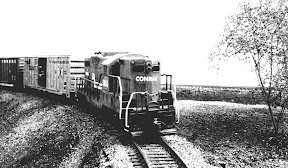How Much Time is Too Much Time?
So lately there have been rumblings that Daddy spends too much time in the train room... Coming out of the cold and rainy season, I can see where this could be a legitimate complaint. There's also the fact that my wife has been toiling away at evening graduate classes three nights a week, so I'm basically unsupervised much of the time. Being an adolescent trapped in a middle aged body, there is all kinds of potential for mischief.
The good news is I've made all sorts of progress on the layout, finishing the infrastructure of a major expansion, adding some cool structures and reworking some key scenery elements. I've also caught up most of the outstanding decoder work that's been piling up. The bad news is that when Laura gets home at night, typically the dishes aren't done, and the kids are still bouncing around well past the certified bed time.
Now that the sun is out a little more, there are other chores that take me away from the layout. Finishing the paint job on the house chief among them. There's also baseball on TV, which my wife and I enjoy sitting together and watching.
Over the years, I've gotten pretty good at breaking layout projects down into bite sized pieces. I can feel like I'm making progress on something in 15 minutes to an hour as time becomes available. Of course, being solidly ADD, I can also be up there for hours at a time either focused on a singular detail, or unfocused and bouncing from project to project.
So anyway, what about this commitment of time... As you may or may not know, this economy hasn't been kind to me or my family, so we're not in a position to take a get-away vacation, or anything like that. The train room has been something of a refuge for me. I guess the trouble is that it is in the attic, and it does keep me beyond the reach of the family a bit. But it's also one of the few places in my world at the moment where I can just close the door and leave the world outside for a while. With her class load, I don't see much of my wife anyway, and my kids are old enough to amuse themselves. I can't sit still long enough to watch a bunch of television (save for the occasional ballgame or movie), so I drift up to the attic where I can feel productive, keep myself amused, and listen to some old records, or the ballgame on the radio.
In the warmer weather, one solution is to move some of my more portable projects down to work on them out on the porch. There I can keep busy, but still have an eye out for skinned knees or geometry homework. In a way, I suppose the hobby can be considered addictive. Like booze or drugs, there's a certain "high" in it, there's peer pressure, a fair amount of expense, and that potential for separation from loved ones. But that defines any hobby, doesn't it?
We all know someone that's gone off the deep end, with trains running around the living room, through the bathroom and across the kitchen counter. There's usually not the risk of annoying a spouse in those cases, however.
So I'll carry on, and strive to strike a balance between the responsibilities of family and the hobby I've enjoyed so much. At least when I'm up there tinkering, everyone knows where to find me.


